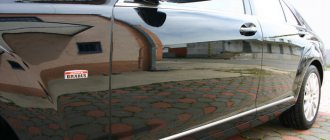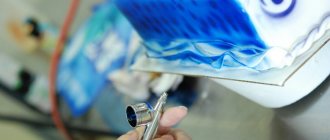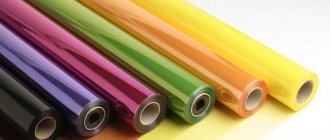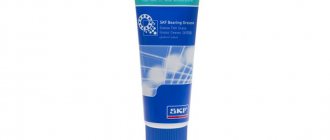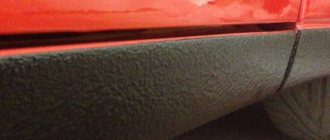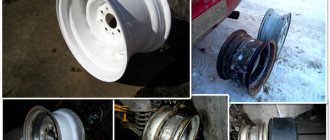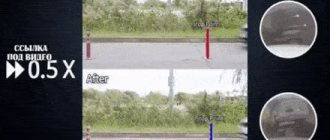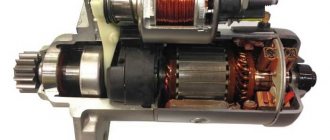Repost and the information will always be at hand ✅
Athermal tinting is a film on car windows to protect the driver from ultraviolet radiation, sunlight and heat. In essence, this is an ordinary film that is applied to the windshield of a car. After installing such protection, the driver will feel comfortable in the cabin.
Llumar film is famous for its quality; it fully performs its function, meets GOST standards, makes being in the car very comfortable and has an average price. I note that the film according to GOST will not save you from prying eyes, but it will cope successfully with the hot sun.
In the article I will tell you everything about athermal tinting: what it is, how it works, advantages and disadvantages, types, prices and best brands, as well as reviews from real car owners. I promise it will be interesting!
Athermal tinting - what is it?
The word “athermal” is derived from the English word “athermal”, which is converted from the word “thermal”. This word is translated as heat-protective, thermal, that is, protecting from elevated temperatures and retaining heat. But here the protection works the other way around - the protective layer protects the car interior from high temperatures, IR and UV radiation.
Athermal tinting or “athermal” is a type of film coating for passenger car windows. The advantage of this material is that it includes several layers that provide good protection from the hot sun.
Let's look at each layer and its specific function:
- The basis . Many manufacturers use polyester. This material is characterized by increased elasticity and sufficient strength; it is on it that all additional layers are applied.
- Adhesive layer . This is the sticker itself, ensuring reliable contact of the material with the glass. Often has UV protection.
- Decorative layer . In principle, this is ordinary paint, giving the material different shades. Black, purple, green can be used. red, blue color. There is also a transparent tint, in which case there will be fewer questions from the traffic police officers. The main task is to block direct sunlight.
- Metallized layer . If it is, then the light transmittance decreases due to reflection. The main property of such a layer is that it absorbs heat, so the heat does not penetrate into the interior of the vehicle. Blocks the operation of radar detectors that are installed near the windshield.
- Protective layer . It is used to provide reliable prevention of the formation of scratches and cracks on athermal tinting. This significantly increases the service life of the material.
The driver can choose the tint shade himself, but it must be taken into account that it must match well with the paint color of the car itself. Some manufacturers have rainbow colors called “Chameleon”, “Dubai”. How do they look? Essentially, they are colorless, but have a specular reflection. It is these athermal tints that most often attract attention and lead to the payment of a fine. This is due to the fact that the light transmittance when used is significantly lower than the declared 70%.
Attention! High-quality film cannot be cheap. If you don’t have the skill to apply it, it’s better to pay extra for the work of professionals, because the risk of ruining the expensive material is high.
Requirements for light transmittance of glass according to traffic regulations and GOST
Clause 7.3 of the Road Traffic Regulations states that it is prohibited to operate a vehicle if it is equipped with coverings or objects that interfere with the driver’s normal visibility. It is further explained:
More on the topic: Bailiffs wrote off money for a traffic fine - what to do and how to get it back?
- Colored transparent films can be attached to the top of the windshield.
- You can use tinted glass (in addition to mirror glass) with light transmission in accordance with GOST 5727-88.
- The rear windows of passenger cars are allowed to be covered with curtains or blinds, provided that there are mirrors on the outside located on both sides.
Another document regulating the level of tinting of ground vehicles is GOST 5727-88. Its paragraph 2.2.4 states that glass that provides the driver with a view of the road must have the following level of light transmission:
- wind - from 75%;
- non-wind, included in the front visibility area - from 70%.
The light transmission of non-window glasses that are not included in the standard field of view is not standardized.
It must be remembered that no car glass is 100% transparent. In most cases, this figure is 85-90%. This feature must be taken into account when choosing athermal film. Without special measuring equipment, this will be problematic, so it is recommended to entrust the application of tinting to the employees of a specialized center. They will make sure all necessary measurements are taken and ensure compliance with the law.
Tinted and painted windshields must provide the correct perception of red, green, yellow, blue and white.
How does athermal tint work?
To understand the principle of operation of a tinting coating, you need to look at the main reasons why it is used:
- to prevent the car from heating up under the influence of sunlight in the heat, the interior heats up little;
- reducing the load on the air conditioning system;
- to give a nice look to the car;
- athermal tinting according to GOST will allow you to avoid a fine;
- reducing the likelihood of driver blinding from external light sources;
- in order to hide what is happening in the cabin from the prying eyes of passers-by.
Athermal tinting has another feature. It provides good protection from the aggressive effects of ultraviolet rays, therefore, unlike conventional film, it works completely differently and this is not an advantage.
In the classic version, the coating simply uses a special composition that blocks access to sunlight. He just doesn't let it pass. Athermal tinting does not block the flow of light directed into the car interior, but reliably protects objects inside, passengers and the driver from infrared ultraviolet waves.
Glass covered with this material is capable of blocking UV waves by almost 100%. Heat protection at 50%. Such high indicators do not make the interior dark; light transmittance remains within 70-75%. It is these conditions that make the coating material an order of magnitude better than the classical one.
What it is?
It’s easy to guess from the name that this type of car window sticker was created to prevent the inside of the vehicle from heating up. Athermal film performs this function in cars due to the fact that it does not transmit infrared and ultraviolet radiation. As a result, the interior and instruments inside the car do not heat up, so tinting the windshield with athermal film is very useful and practical.
By the way, among all the varieties of athermal film, chameleon film is also distinguished. Its peculiarity is that the chameleon’s athermal tinting changes its transparency depending on the intensity of the lighting outside.
That is, when it is very light outside and the sun is bright, the “chameleon” film is as dark as possible, even with a mirror reflection. When it’s twilight or cloudy outside, the athermal chameleon tint becomes almost transparent.
Advantages of tinting with athermal film:
- there is no heating of the interior through the windshield and side windows;
- the interior of the car does not fade;
- visibility is not reduced;
- the load on the driver's eyes is reduced;
- on sunny days, gasoline is saved by running the air conditioner.
However, all these advantages are good, but do not answer the main question - is athermal tinting allowed according to GOST or not? But here we need to figure it out.
Types of colors and films
A variety of films are used to tint car windshields and side windows. They are presented in an assortment, have different colors and compositions. If you compare them in appearance, structure and quality, at first glance it seems that they are the same. The main difference is the price. Some athermal tints are much more expensive than others. Why? To deal with this issue, you need to consider the main options:
- Metallized . This is a layer with a mirror effect that provides protection from thermal and solar influences. Contains a special polymer. Each manufacturer uses its own spraying technology. There are options for applying to the outer and inner layer. The films have one, but rather significant, drawback. They are noise-canceling and can create some interference with radios and other equipment (for example, radars, navigators, mobile phones). The light transmission characteristics may not be enough for a comfortable trip, but it copes well with the sun's rays.
- Painted. This is a multi-layer polyester material. They have certain shades or are transparent. They prevent color fading. The advantages of colored athermal tinting are its relatively low price, reliability, availability in many stores, and a sufficient range of shades.
Athermal tinting Chameleon - Spatter . They are analogues of metallized ones, but the alloy fraction in them is much smaller. The polyester substrate is coated with iron of different alloys, so maximum homogeneity is achieved. The advantage of film is that it is invisible.
- Metallized-spatter . They have good characteristics inherent in other species. Provide maximum protection against ultraviolet exposure and block sun rays harmful to the driver's eyes. The main disadvantage of the material is the price, and the advantage is minimal wear resistance.
Another good article: What is car restyling: what does the word mean, is it a scam, photo
Athermal tinting of front windows can be carried out using special technologies. It must be borne in mind that it is impossible to use any film that you like, because this may entail a fine from law enforcement officers. The legal percentage of shading, even with athermal tinting of the side windows, is no more than 30% . Other indicators when taking measurements by government officials may become a reason for a monetary penalty.
What color types are there?
- Chameleon (has an iridescent hue);
- Blue (quickly causes eye fatigue);
- Light green;
- Blue;
- Aquamarine;
- Brown;
- Violet;
- Orange;
- Red;
- Green.
First about simple tinting
A tinted car attracts the attention of traffic police inspectors from afar. The following is the standard procedure:
- measurements of light transmission - be it athermal tinting, “chameleon” or simple dark,
- issuing a ruling in the event that light transmission is ultimately prohibited,
- drawing up a request to stop the offense - the driver is de facto prohibited from driving a car with tinted windows. All that remains is to “tear off” the film on the spot so that the conflict with the law is settled.
Therefore, tinting the front hemisphere is gradually going out of fashion.
But where to put your hands?
However, a man remains a man even in a city apartment and longs to remain a hero. This is in your house: you straightened the fence - a hero, re-laid the roof - a hero, heated the bathhouse - you are the center of the universe. What to do with your hands in the city?
The car becomes a kind of outlet for a man’s inexhaustible energy, or, better said, a testing ground for self-affirmation.
And, if regular tinting is prohibited because it reduces the light transmission of the glass, the idea arises of applying a film to the windshield and side windows that does not attract the attention of inspectors and can be allowed. This is where we talk about athermal tinting.
Is such a film possible?
Sunlight, in addition to the visible spectrum, consists of infrared and ultraviolet ranges. To reduce interior heating, windshields are made using various technologies. It could be:
- laminated glass, when heat-reflecting layers are applied between layers of glass,
- athermal glass filled with metals or metal oxides.
The latter technique is also used by manufacturers of athermal films. Taking the usual transparent one as a basis, layers with filler are applied to it. Moreover, the more layers of different fillers, the more interesting the result shimmers depending on the lighting conditions.
For an athermal film with many layers, they came up with their own name - “chameleon”. The number of layers here reaches twenty.
When producing such a coating, the manufacturing company needs to solve a difficult problem - it should not glare. Glare will interfere with other drivers. There is nothing stupider than getting into an accident because you are blinded by the glass of your own car. After being blinded by headlights or glare, one in ten drivers takes more than 60 seconds to regain their vision. If such a driver is blinded by the glare of your film and comes at you head-on, then you may be to blame for the accident.
Pros and cons of athermal tinting
List of advantages of athermal:
- Laconic appearance of the car. It becomes more “expensive”, spectacular and stylish.
Athermal tinting gives the car a spectacular style - The comfort of all passengers in the cabin increases due to the effect of hiding from prying eyes.
- The likelihood of burns is reduced . In many cases, ordinary glass acts like a lens, concentrating radiation in one place, causing your hands to burn. Atermalka will protect the skin from harmful radiation.
- Reliability indicators are increasing . Attackers simply won’t notice the driver’s handbag with documents accidentally left behind.
- Objects in the cabin , plastic parts (especially the dashboard - the front panel in the car interior) are better preserved. Seat coverings (especially leather ones) do not fade or deteriorate from exposure to sunlight when the car is stored outside.
- Even without the use of a climate control system, in the summer the cabin will be comfortable because the intensity of light and heat passing through the athermal tint will be less. In some cases, you can even do without air conditioning, which will save some fuel.
- The view is not reduced due to good transparency.
- Glare is partially .
- An additional level of protection for people in the car in the event of glass breaking from the outside. Athermal tinting protects the glass from damage from inside the car.
But during operation, car owners notice not only the benefits of the coating. Disadvantages also become visible.
- The first and most significant drawback is increase in the frequency of nagging from traffic police officers. They constantly stop cars with such a coating and check the transmission of light. This is done with a special device. And most importantly, it often shows different values due to insufficient accuracy. The indicators obtained during measurement vary depending on environmental conditions.
Traffic police inspectors often stop cars with athermal tint - Another disadvantage may be the choice of shade , since not everyone will like colored or iridescent film.
- Overpriced for the film , as well as for its installation.
- Deterioration in the performance of radar detectors and other electronics in the case of using metallized athermal tinting.
- Over the years, the light transmittance of glass deteriorates . Therefore, such tinting will have to be replaced after some time.
- Athermal tinting of blue shades causes increased eye fatigue for the driver.
- On a bright sunny day, a dashboard (especially light-colored ones) can be reflected on the windshield , impairing the driver’s visibility.
- If the car is old, then the level of shading may not meet the standards due to the fact that the original glass fades over the years.
Attention! When using the material, driving safety is reduced, especially when driving in reverse. When there is insufficient lighting, the visibility of the road is noticeably reduced. This only applies to low-quality materials, so you shouldn’t skimp on quality.
What tint is legal?
At the moment, there is a huge selection of films used for athermal tinting. They differ both in light transmittance and in transmittance of heat and ultraviolet rays.
- Traffic police officers very often stop cars with regular tinting, since this tinting can be seen with the naked eye.
- Next, the traffic police officer checks the light transmittance of the windshield for compliance with technical regulations using a special measuring device.
- If the light transmittance of the windshield is less than 70%, the driver will be fined and the tint film will be forced to be removed.
As for the athermal film on the windshield, reviews from the traffic police say that it all depends on what model of film you use, if they are transparent models, then there should be no problems, firstly, such a film is quite difficult to notice, and not every traffic police inspector will stop you to check the light transmittance of your glass. As for other models, it is worth paying close attention to compliance with technical standards. Solving this issue is quite easy. You need to take a small piece of film and stick it tightly onto the glass of your car. Specialized salons can always help you check the tint and choose an alternative if it does not meet the established standards.
What is the difference between athermal tinting and regular tinting?
Athermal tinting is used to protect against heat and sun exposure in hot summers. The advantage of athermal is that it is able to adapt to environmental conditions, changing light transmittance.
The term “athermal film” often means “chameleon” type coatings, but this is not entirely correct. The chameleon is a separate species and has a distinctive spectrum of light transmission.
The densest ones with maximum protection are often prohibited in Russia and other European countries, and punishment is imposed for their application.
If the driver doesn’t like athermal tinting, but wants to protect the interior from overheating, there are the following analogues on the car market:
- Mirror foil film, which is attached from the inside to the windshield. It reflects sunlight well. This is the cheapest athermal, but inconvenient, since you have to constantly remove and install it every time you get out of the car.
Sunshade for windshield - Metallized film . It has a metallic effect, reflecting some of the sun's rays. The downside is that it does not protect well from IR and UV radiation.
- Frame car curtains . They are placed on the inside of the side window and are easy to remove. They only protect from the side effects of the sun.
The reaction of traffic police officers to athermal tinting
It is difficult to answer the question whether “chameleon” tinting is allowed or not, for the simple reason that GOST and traffic rules do not generally prohibit tinting a car, any kind.
Russian legislation and the related GOST regulate the light transmission capacity of the windshield and side windows, and not the presence or absence of any films or tinting.
That is, the front windows of a car must transmit 70% of all the light that falls on them. If this requirement is met (this is checked with a special device), then the traffic police officer does not and cannot have any questions. .
But if the glass is not transparent enough, then this is already a violation that can lead to a fine.
As for the actual athermal tinting, its light transmission capacity for most manufacturers is at around 80%. Naturally, if you buy and stick a sufficiently high-quality film.
Accordingly, if such a film is applied to absolutely transparent glass, then the permission for athermal tinting is not questioned, which means the question of whether athermal tinting is allowed is resolved by itself. Please apply and enjoy your progress in a cool salon.
However, in practice there are no absolutely transparent glasses and they block at least part of the light. Car manufacturers claim that factory-installed windshields and side windows are 90% transparent. What follows from this and will athermal windshield tinting save drivers?
The price of athermal tinting and its installation
Among the main manufacturers of tint films, American and Korean brands are popular. They are all necessarily marked “Overtinted” or “Tint”.
To understand the advantages of individual companies, it is worth making a comparison. American materials are distinguished by increased light transmittance and wear resistance, but have a significant drawback - they are overpriced. Among the popular manufacturing companies that occupy high positions in the ratings are:
- Mistique Clima;
- SunTec;
- Ultra Vision;
- Llumar
Another good article: What is LPG in a car: explanation, types, device, is it worth installing gas equipment
Korean films are more accessible to consumers, but their quality is significantly lower. Often the material inside the package does not meet the standards described in the annotation. The best among these companies are NexFil and Armolan.
Basically, trusted companies produce their products in large rolls, intended for wholesale purchase by specialized workshops involved in gluing films and painting vehicles. Only certain companies have in their assortment “amateur” options, presented in sections of 1-1.5 meters. Usually their size is sufficient for application to the front side windows. The cost of a small roll is from 2000 to 3500 thousand rubles.
In Russia, only one factory produces athermal glass - the Bor Glass Factory. I note that Japanese manufacturing technology is used here.
Attention! If you have no experience in carrying out such manipulations, it is better to entrust the car to a professional. Otherwise, there is a risk of ruining the thin material and being left without tinting.
Prices for work vary, they depend on the experience of the master, the region of Russia and the service center. On average, in Moscow, they charge about 5,000 rubles for applying athermal tint to the windshield of a station wagon or sedan. (for 2021). For the front side ones you will have to pay a little less, approximately 2500-3000 rubles. Those who want to tint all their cars in a circle should prepare 8,000 rubles. excluding payment for materials.
I recommend contacting a specialist who will do the job efficiently. If you turn to specialists who undertake not only tinting, but also other repair work, then the quality of such work will leave only the best.
Advice! It is best to install film from the UltraVision brand (not very expensive, good quality, many types of models) and Llumar (expensive film of excellent quality, a model for other companies).
What athermal film is acceptable?
Athermal tinting is conditionally permitted, but it can be applied to glass only if a number of rules are observed, which some manufacturers neglect.
Most often the question arises whether it is allowed to glue athermal film to the windshield. Yes, but its light transmittance level should not be lower than 70%. You will have to spend time taking measurements, but if the car is new, the efforts will be justified - the standard result after installing the film is 76.5% light transmittance, which corresponds to the norm. After several years of active use, the glass may become cloudier, so it is recommended to repeat measurements periodically.
More on the topic: Changed license, old insurance number - what is the fine and risks?
Athermal tinting “Chameleon”, capable of changing light transmission depending on the intensity of light, often reflects quite strongly, so the driver may face problems when passing the test. This feature of “Chameleon” is due to the fact that this type of film consists of many metallized layers, which not only change the color of the tint, but also mirror the image.
This film may have different light transmittance depending on the time of day and temperature. Indicators may also vary across the width of the film. It is thanks to these features that the “chameleon” effect is achieved. Unfortunately, models of the domestic automobile industry and inexpensive foreign cars with chameleon film will not comply with the standards established by law, especially if they have been in use for more than one year, and there are cracks or cloudy areas on the glass. There is only one way out - replace the glass with new ones.
Purple athermal tint is most often installed on the rear window because it darkens the windows significantly. It is only allowed to be glued to windows with a light transmittance of at least 91%. This indicator can only be found in new glasses. In addition, the result largely depends on the quality of installation. In the worst case, the scatter can reach 7% in different areas of the glass.
GOST and traffic police: is athermal tinting on the windshield allowed?
Is it possible to glue athermal film to the windshield of a car? There are no prohibitions in this regard. The main thing is to maintain the necessary bandwidth.
There are no GOST standards for glass tinting. There are only regulations adopted by the State Traffic Safety Inspectorate in accordance with the safety amendment. What athermal film passes GOST standards?
According to the requirements set out in it, the permeability of glass that provides visibility to the driver from the front (front and side) must be at least 70% (GOST 32565-2013, clause 5.1.2.5).
When taking measurements, it is absolutely not important what athermal tinting is used, the main thing is that the transport police officer sees values lower than recommended on his measuring device. If the car is equipped with external rear-view mirrors, then the light transmission of the rear windows is not standardized.
Measuring light transmittance using a taumeter
There are certain nuances. All glass from the manufacturer is initially slightly darkened, so the transmittance of light through it will not be 100% - such glass simply does not exist in nature. If you use the “lightest” material, the light transmittance of 90% will decrease by another 20%, that is, the original 70%. Drivers who decide to install a chameleon are putting themselves at risk because its throughput is even lower.
All athermal tints provide sufficient throughput in accordance with technical regulations. But the problem with its lack often arises due to “original” glass without coating. They may initially be darkened not by 10%, but by 15-20%, then applying the coating ends with a fine.
Is there a solution to the problem? It is possible to prevent foreclosure.
It is enough to stick a small piece of film on the car window and take measurements.
Doing this is problematic only because getting the device (taumeter) available to traffic police officers is quite problematic. You will have to contact them, explain that you do not want problems with the law and want to clarify whether the coverage will comply with technical regulations. This will help save money.
Are you fined for using athermal film? The fine for glass with light transmittance of more than 70% for 2021 is 500 rubles (Article 12.5, Part 3.1 of the Code of Administrative Offenses of the Russian Federation).
About making changes to the design
As I said above, any actions with the car are changes to the design. But not all of them need to be registered with the traffic police. The following are not registered.
- Changes when non-original spare parts or pieces of equipment certified as part of this vehicle are installed on a vehicle. The simplest example: installing non-original wipers. It is enough that the wiper packaging indicates that they have been certified as part of your car.
- Provided in the operating instructions. An equally simple example is installing a radio in a car.
- If the athermal film has been tested as part of your car, as stated in the certificate attached to the film, or the application of tinting is provided for in the operating instructions for your car, then you do not need to register it with the traffic police and it is permitted provided the light transmittance of the window is at least 70%. Otherwise, you need to go all the way to register changes to the design.
Will they issue a fine?
It is highly likely that there will be no fine for unregistered changes. The procedure for proving an offense in this case is quite complicated:
- in full accordance with the law, it is necessary to initiate an administrative investigation,
- collect the necessary evidence,
- then – consideration of the case in court.
No one in the traffic police will waste time on this.
In conclusion, when I have an unbridled desire to experiment with the car, I go to the store and buy new windshield wipers. First of all, it's cheap. Secondly, replacing them yourself is not difficult. And thirdly, I feel a feeling of complete satisfaction from the work I did with my own hands.
How to install and remove athermal film from a windshield with your own hands
The process of applying film to car glass cannot be called simple, but it is quite possible to do it yourself. This will require patience and certain tools:
- detergent;
- soft spatula with a long handle;
- construction hair dryer (you can use a household hair dryer, but it will be more difficult to work with);
- a knife for trimming (a stationery knife is suitable);
- pieces of clean fabric.
Then they work according to the following algorithm:
- The outside of the glass is thoroughly washed with clean water using a foamy detergent and rinsed until the glass is completely soapy.
- The film is placed on the wet glass, placing the lining on top. If the roll is large, it is laid out so that the main part is on the roof of the car.
- Next comes pruning. The piece is cut out so that it is slightly larger than the surface to be pasted.
- Form the coating using a powerful hair dryer. You should work carefully so that the air flow does not spoil the film and the car glass itself. You cannot heat the material with points, otherwise it will become unusable; it is important to direct the flow along the entire perimeter.
- When heated, the liquid quickly evaporates, so additional humidification is provided with a spray bottle.
- The material used must be distributed from the center to the edges, so the main part is heated first. The film is stretched so that later it does not form lumps.
- A spatula with an extended handle is used to smooth out formed creases. This is done directly during heating. It is important not to hold the spatula in one place.
- After distribution, the film is cut with a grip on the edge of the sealing gum. It is convenient to use a sharp stationery knife. It is necessary to cut in one motion, otherwise the film will go to the side and tears will appear on it.
- Next we begin to prepare the inner glass. All elements that can touch and damage the material are removed from it.
- Further work is carried out according to the same algorithm.
Another good article: Snorkel: what is it, what is it for, pros and cons, how to make it yourself
Watch an interesting video of how a car windshield is tinted with Chameleon tinting.
Attention! Keep in mind that the film can take up to 10 days to completely dry. During this period, you can drive the car, but it is not recommended to lower the side windows if they have been treated, or to wash the car.
How to remove athermal tint? To remove material from the surface without any problems, you will also need certain tools:
- sharp knife;
- any detergent;
- clean rags;
- scraper.
Next, the film is removed. It is pryed off with a sharp tool so as not to scratch the glass. The cut is bent from the edges and slowly pulled down. You should treat the film with a detergent composition as often as possible, this will make it come off easier. After partial removal, we begin to work with a scraper. Use it to remove small particles and then rinse the surface with plain water.
If the above manipulations do not help remove the coating, you can use acetone-based solvents. They are applied pointwise to problem areas using a sponge, and then the area is washed with water. Prolonged exposure of glass to caustic agents is undesirable because unsightly stains may form on it.
By the way, a metallized film of a green or purple hue is installed at the manufacturer. Under normal conditions, it is impossible to produce high-quality metal spraying.
Here is a useful video on how to remove tint from a car in five minutes.
Glass transparency
Can I apply athermal tint? Can.
Simple calculations give us the following - glass transparency 0.9 multiplied by film transparency 0.8 gives the product 0.72.
That is, new glass with athermal tinting is 72% transparent, which is what the traffic police officer’s device will show. There are no contradictions to GOST and there are no grounds for a fine, which means that athermal glass tinting has the right to exist.
But the problem lies in the fact that when using a car, the glass is subject to wear and tear. And very soon, they are covered with microscopic scratches and abrasions invisible to the eye.
This results in a reduction in transparency of up to 85% or even 80%.
What happens in this case is easy to calculate mathematically:
0.85 * 0.8 = 0.68 (or 68%)
0.8 * 0.8 = 0.64 (or 64%)
As can be seen from the examples above, such glass with athermal tinting no longer meets the requirements of Russian GOST, therefore tinting is not permitted.
If the traffic police inspector's testing device comes to a place with insufficient transparency of the glass, it will show a deviation from the norms of the law.
Test of the best athermal tints for light transmittance
What are the best heaters to install on your favorite car? The test results are discussed in the following table. Based on it, we can make an assumption about how quality the product of individual manufacturers is according to various criteria. The table shows the scores given by each company for a certain nomination, and the final column summarizes the results.
| Film | Light transmittance | Blocks UV rays | Protective effect | Total points for nominees |
| AIR 75 CH SR HPR | 5 | 5 | 4 | 14 |
| 3M Crystalline 70 M | 5 | 4 | 5 | 14 |
| Llumar AIR BO BL SR HPR | 4 | 4 | 5 | 13 |
| Ultra Vision XAIR BO CH | 4 | 5 | 4 | 13 |
| Ultra Vision XAIR BO BL | 5 | 4 | 5 | 14 |
| Ultra Vision Mystique Clima Comfort | 4 | 4 | 5 | 13 |
| Ultra Vision Mystique Light | 4 | 5 | 4 | 13 |
According to the results of the studies, films from these manufacturers differ in good performance. All of them have a fairly high price. Tinting a car in Russia using these materials will cost approximately 12-15 thousand rubles.
What to do? To apply or not?
There is no clear answer to this question, whether to use a tinting tool or not. There are only general tips that can tell you what to do.
Service center specialists advise applying athermal tinting immediately after purchasing a car, when it still has unworn factory glass with maximum transparency. Still, they should be tested in different places before applying the film.
You can try applying such a film to one of the side windows, and then use a special device to check how transparent this combination is. If the GOST requirements for tinting are met, then there is no problem and you can apply “athermal” to the rest of the glass and purple athermal tinting will become your savior in the hot season.
It is worth saying that a bill has already been submitted to the State Duma of the Russian Federation, which provides for an increase in fines for tinting. If it is adopted, drivers will pay not 500 rubles, as now, but 1,500 rubles.
In addition, the same bill proposes to establish a fine of 5,000 rubles for a repeated similar violation. And in some cases it even involves the deprivation of a driver’s license.
What to consider during inspections
If the traffic police inspector decides to check your tint, remember the following rules:
- Measurements can be taken at any time of the day (modern taumeters have their own light source);
- Light transmission cannot be measured on wet glass (the surface must be clean and dry). If you are tested in the rain, refuse to accept the results;
- The measurement is carried out at three different points on the glass (then the average parameter is calculated);
Important! Unscrupulous police often put a dark film on the taumeter, which distorts the final readings of the device. Even before taking the measurement, carefully inspect the official’s taumeter: you have every right to do this!
